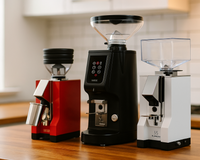Introduction
Espresso, with its rich aroma and bold flavor, is a staple in the daily lives of millions of coffee enthusiasts around the world. But beyond its ability to energize and delight, many of us wonder about the specifics of its caffeine content. Specifically, how much caffeine is in a shot of espresso? This question isn't just for the curious; it's crucial for anyone mindful of their caffeine intake.
Are you a coffee lover who wants to understand the caffeine content in your favorite brew? Look no further - this ultimate guide has got you covered. Whether you're sipping on a steaming cup of Joe or indulging in a rich espresso shot, it's important to know how much caffeine you’re consuming. In this comprehensive guide, we'll explore everything you need to know about the caffeine content in coffee and espresso. From understanding the factors that influence caffeine levels to learning the difference between Arabica and Robusta beans, we'll break it all down for you. Not only will we discuss the impact of brewing methods on caffeine concentration, but we'll also debunk common myths surrounding coffee and its caffeine content. Plus, we'll provide some helpful tips for those seeking a lower caffeine brew or wanting to maximize their caffeine intake.
By the end of this guide, you'll be equipped with the knowledge to make informed choices about your coffee consumption. So grab your favorite mug and get ready to dive into the world of coffee caffeine content.
YOU MIGHT LIKE: COFFEE VS TEA - WHICH IS BETTER FOR YOUR HEALTH?
What is Espresso?
Espresso is more than just a strong cup of coffee—it is a unique brewing method that originated in Italy in the early 20th century. Traditionally, it is made by forcing a small amount of nearly boiling water through finely-ground coffee beans under high pressure. This method produces a concentrated, thick, and creamy coffee shot known as espresso.
The magic of espresso lies in its preparation.
The coffee beans used for espresso are ground much finer than those used for regular coffee, which allows for a more efficient extraction of flavors and oils. Additionally, an espresso machine uses between 9 and 15 bars of pressure to extract the coffee, a process that typically takes about 25 to 30 seconds for a single shot. This quick and intense brewing method not only maximizes flavor but also creates the signature crema on top—a golden, creamy layer that forms naturally during the extraction process and is considered by many as the hallmark of a well-made espresso.
Caffeine Content in a Shot of Espresso
When it comes to caffeine, espresso packs a significant punch in a small package. A standard shot of espresso, which is about 1 ounce (30 ml), typically contains approximately 63 milligrams of caffeine. However, this amount can vary depending on several factors that influence the extraction process.

Factors Affecting Caffeine Levels in Espresso:
-
Type of Coffee Beans: The choice of coffee beans plays a crucial role in determining caffeine content. Robusta beans contain almost double the caffeine of Arabica beans. Therefore, espresso made from Robusta will be more caffeinated than one made from Arabica.
-
Grind Fineness: The finer the coffee grounds, the more surface area is exposed to the water, increasing caffeine extraction. Espresso uses a very fine grind, which is why it can extract a lot of caffeine in a short brewing time.
-
Brewing Time: The longer the water is in contact with the coffee grounds, the more caffeine is extracted. Espresso's brewing time is short, but because of the high pressure used, it still extracts a substantial amount of caffeine.
-
Amount of Coffee Used: More coffee grounds mean more potential caffeine. A double shot of espresso, using roughly 18 grams of coffee, will naturally contain more caffeine than a single shot using about 9 grams.
In the following sections, we will compare the caffeine levels in espresso to those found in other popular coffee beverages, shedding light on why espresso might be your best choice for a caffeine boost or when you might want to opt for something a bit lighter.
YOU MIGHT LIKE: HOW TO CHOOSE A PROSUMER ESPRESSO MACHINE
Comparing Caffeine: Espresso vs. Regular Coffee
While espresso is renowned for its bold flavor and concentrated caffeine, how does it really stack up against regular drip coffee in terms of caffeine content? Understanding this comparison can help coffee drinkers make informed choices based on their caffeine preferences.
Caffeine in Espresso:
As mentioned earlier, a single 1-ounce shot of espresso contains about 63 milligrams of caffeine. This concentration makes espresso one of the most caffeine-dense forms of coffee per ounce.
Caffeine in Regular Drip Coffee:
In contrast, a typical 8-ounce cup of drip coffee contains roughly 95 milligrams of caffeine. Although the total caffeine content is higher in a full cup of drip coffee compared to a single shot of espresso, the concentration of caffeine is much lower. Drip coffee usually contains about 12 milligrams of caffeine per ounce, significantly less than the 63 milligrams per ounce in espresso.
Visual Comparison:
To visualize this difference, imagine you drank an 8-ounce cup of espresso. If such a cup existed, it would contain approximately 504 milligrams of caffeine—over five times the caffeine of a regular cup of drip coffee. However, since espresso is typically served in small amounts, most people consume less total caffeine per serving compared to a full cup of drip coffee.
Choosing Your Coffee Based on Caffeine:
For those who need a quick burst of energy, a shot of espresso provides a rapid caffeine jolt. Conversely, if you prefer a prolonged, more gradual intake of caffeine, regular drip coffee may be more suitable. Additionally, the choice between espresso and drip coffee can also depend on taste preference and the desired intensity of coffee flavor.
YOU MIGHT LIKE: IS THERE CAFFEINE IN COFFEE ICE CREAM?
Espresso: a concentrated caffeine powerhouse
Espresso is a unique and concentrated form of coffee that is renowned for its intense flavor and high caffeine content. Unlike drip coffee, which is typically brewed with a larger volume of water, espresso is produced by forcing hot, pressurized water through a compact puck of finely ground coffee beans.
This high-pressure extraction process results in a small, concentrated serving of coffee that is typically around 1-2 ounces in volume. However, despite its small size, a single shot of espresso can contain anywhere from 63 to 100 milligrams of caffeine, depending on factors such as the coffee blend, grind size, and brewing parameters.
The high caffeine content in espresso is due to the efficient extraction process, which is able to extract a larger percentage of the caffeine and other compounds from the coffee beans. Additionally, the small serving size of espresso means that the caffeine is more concentrated in the final beverage, resulting in a potent caffeine punch.
For those who are looking to maximize their caffeine intake, espresso can be an excellent choice. However, it's important to keep in mind that the high caffeine content can also lead to adverse effects, such as jitters, anxiety, and insomnia, particularly for individuals who are more sensitive to caffeine. As with any caffeinated beverage, it's important to consume espresso in moderation and to be mindful of your personal caffeine tolerance.

Decaffeinated coffee: myth or reality?
Decaffeinated coffee has long been a topic of debate and misconception. Many people assume that decaffeinated coffee is completely free of caffeine, but this is not entirely accurate. While decaffeinated coffee does contain significantly less caffeine than regular coffee, it is not entirely devoid of the stimulant.
The process of decaffeinating coffee beans involves the removal of a significant portion of the caffeine, typically around 97% or more. This is achieved through various methods, such as using chemical solvents, carbon dioxide, or water to extract the caffeine from the beans. However, even after this process, a small amount of caffeine remains in the final product.
On average, a cup of decaffeinated coffee contains around 2 to 12 milligrams of caffeine, compared to the 95 to 200 milligrams found in a typical cup of regular coffee. While this is a significant reduction, it's important to note that the exact caffeine content can vary depending on the specific brand, brewing method, and even the individual coffee beans used.
For individuals who are highly sensitive to caffeine or are seeking to completely eliminate it from their diet, decaffeinated coffee may not be a suitable option. However, for those who want to reduce their caffeine intake while still enjoying the taste and ritual of coffee, decaffeinated coffee can be a viable alternative. It's important to remember that even though decaffeinated coffee contains less caffeine, it is not entirely caffeine-free, and individuals should still be mindful of their consumption.
How Does Espresso's Caffeine Affect Your Health?
Caffeine, the most widely consumed psychoactive substance in the world, naturally plays a significant role in the daily lives of coffee drinkers. The caffeine in espresso, while providing various benefits, also poses potential risks if consumed in excess.
RELATED: THE NUTRITIOUS VALUE OF COFFEE
Health Benefits of Caffeine in Espresso:
- Improved Mental Alertness and Cognitive Function: Caffeine in espresso can enhance brain function, leading to increased alertness, improved mood, and boosted cognitive performance.
- Increased Metabolism and Fat Burning: Caffeine is a common ingredient in commercial fat-burning supplements; it can boost the metabolic rate and increase fat burning in the short term.
- Enhanced Physical Performance: By stimulating the nervous system, caffeine can signal fat cells to break down body fat, making free fatty acids available as fuel, thereby improving physical performance.
Potential Health Risks of Excessive Caffeine Consumption:
- Anxiety and Restlessness: Given its stimulating effects, too much caffeine can lead to feelings of anxiety, jitteriness, and agitation.
- Disrupted Sleep Patterns: Consuming caffeine late in the day can interfere with your sleep cycle, leading to sleep disturbances and insomnia.
- Digestive Issues: While a moderate intake can boost stomach acid production, aiding digestion, higher amounts may lead to gastrointestinal discomfort and acid reflux.
- Increased Heart Rate and Blood Pressure: Temporary increases in heart rate and blood pressure are common with caffeine, which might be concerning for those with certain cardiovascular conditions.
How caffeine affects the body
Caffeine is a widely consumed stimulant found in various beverages, including coffee, tea, and energy drinks. When consumed, caffeine is rapidly absorbed into the bloodstream and travels to the brain. Once in the brain, caffeine blocks the action of a neurotransmitter called adenosine, which normally binds to receptors and promotes feelings of drowsiness and relaxation.
By blocking adenosine, caffeine causes an increase in the activity of other neurotransmitters, such as dopamine and norepinephrine. This increased neural activity leads to a range of physiological effects, including improved mood, enhanced cognitive function, and increased energy and alertness. Caffeine also stimulates the release of adrenaline, which can lead to a temporary increase in heart rate, blood pressure, and breathing rate.
However, it's important to note that the effects of caffeine can vary from person to person, depending on factors such as age, body weight, genetics, and individual sensitivity. Some people may experience more pronounced effects, while others may be less sensitive to caffeine's stimulant properties. Additionally, consuming too much caffeine can lead to adverse effects, such as anxiety, jitters, insomnia, and even heart palpitations, particularly in individuals who are more sensitive to its effects.
Tips for managing your caffeine intake
For coffee and espresso lovers who want to enjoy their favorite beverages while maintaining a healthy caffeine intake, there are several strategies to consider:
- Understand your caffeine tolerance: Pay attention to how your body reacts to different amounts of caffeine and adjust your consumption accordingly. Some individuals may be more sensitive to caffeine than others.
- Opt for smaller serving sizes: Instead of a large cup of coffee, consider a smaller serving size, such as a 12-ounce cup or a single shot of espresso. This can help you manage your caffeine intake more effectively.
- Experiment with brewing methods: Try different brewing methods, such as pour-over or cold brew, which can result in a lower caffeine concentration compared to traditional drip coffee or espresso.
- Choose Arabica over Robusta: Opt for coffee blends or single-origin Arabica beans, which generally have a lower caffeine content than Robusta beans.
- Incorporate decaffeinated options: Incorporate decaffeinated coffee or espresso into your routine, especially later in the day, to reduce your overall caffeine intake.
- Stay hydrated: Drink plenty of water throughout the day to help offset the dehydrating effects of caffeine.
- Pay attention to other caffeine sources: Be mindful of other sources of caffeine in your diet, such as tea, energy drinks, and chocolate, and factor them into your overall caffeine consumption.
- Consult with a healthcare professional: If you have any underlying health conditions or concerns about your caffeine intake, it's always best to consult with a healthcare professional for personalized advice.
Conclusion
We have explored the intriguing question: how much caffeine is in a shot of espresso? As we've discovered, a single shot of espresso contains about 63 milligrams of caffeine, though this can vary based on factors like the type of beans used, the grind size, and the brewing technique. Espresso offers a concentrated dose of caffeine that can enhance mental alertness and physical performance, making it a favored choice for a quick energy boost.
However, it's also important to be mindful of caffeine's potential effects on health. While moderate consumption can offer significant benefits, excessive intake may lead to adverse effects such as anxiety, sleep disturbances, and digestive issues. By understanding these impacts and how to manage your caffeine consumption, you can enjoy espresso as a delightful part of your routine without compromising your health.















